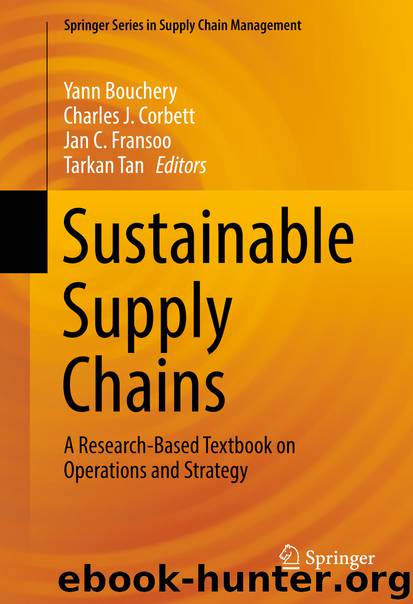Sustainable Supply Chains by Yann Bouchery Charles J. Corbett Jan C. Fransoo & Tarkan Tan

Author:Yann Bouchery, Charles J. Corbett, Jan C. Fransoo & Tarkan Tan
Language: eng
Format: epub
Publisher: Springer International Publishing, Cham
10.9 Local Regulation or Global Goals ?
Another major concern in dealing with end-of-life products is their leakage from the regulated work management systems due to exports: As end-of-life product waste is costly to process, exporting the waste to developing areas such as Africa and Asia may become an attractive option to producers. The processing costs in these areas are typically much lower due to the lack of stringent processing requirements and the availability of cheap labor. Obviously, this is bad news for the exporting area because when the waste leakage is not properly handled, the effectiveness of regulation in meeting the environmental objectives is seriously undermined. On the other hand, mishandled waste poses an acute hazard to the health and environment in the destination areas of waste export. Note also that such global leakages of environmental externalities are not unique to the take-back context. Similar observations have been made for emissions leakage as well (see Sunar 2015; Drake and Just 2015; Islegen et al. 2015).
In view of this real threat that has already been observed in the practice of electronics recycling (e.g., documented in BAN 2005), the European Union has ratified the Basel Convention, which is an export restriction that prohibits export of end-of-life products. Nevertheless, although dumping waste is unacceptable, the export of used but still functioning products to developing countries may be allowed. The rationale is that exporting functional used products can be a win–win solution. It helps manage the unwanted items in the developed country and provides people in a developing country with affordable access to used products. This forms the foundation for what we call partial export restrictions, under which used products in working condition are permitted for export while end-of-life products are not. A similar example is the introduction of the Responsible Electronics Recycling Act in US Congress in 2011 (Kyle 2011).
Some NGOs, such as the Basel Action Network, however, argue that it may be beneficial to ban exports of even used products, i.e., a full export restriction. As we compare the partial export restriction to the full export restriction, we have to keep in mind that producers may utilize the used products pulled off the secondary market along with the end-of-life products to fulfill the recovery obligation as aforementioned. Then allowing used products with remaining lifespans to be exported may accentuate this type of secondary interference that has been shown to be environmentally unfavorable. Therefore, the problem becomes of concern that how do different stringencies in export regulation (none, partial or full restriction) differ in terms of environmental performance. This problem is addressed in Alev et al. (2014a).
In Alev et al. (2014a), the setup and assumptions for this problem are the same as in the main model exhibited earlier. When products are exported from the developed country to a developing country, the associated unit recycling cost is reduced to reflect the lower cost in the developing country due to cheaper labor or lower processing stringency requirements. The authors then compare the partial and the
Download
This site does not store any files on its server. We only index and link to content provided by other sites. Please contact the content providers to delete copyright contents if any and email us, we'll remove relevant links or contents immediately.
Hit Refresh by Satya Nadella(8325)
The Compound Effect by Darren Hardy(7540)
Change Your Questions, Change Your Life by Marilee Adams(6632)
Nudge - Improving Decisions about Health, Wealth, and Happiness by Thaler Sunstein(6626)
The Black Swan by Nassim Nicholas Taleb(6179)
Daring Greatly by Brene Brown(5632)
Deep Work by Cal Newport(5446)
Principles: Life and Work by Ray Dalio(5312)
Rich Dad Poor Dad by Robert T. Kiyosaki(5137)
The Myth of the Strong Leader by Archie Brown(4783)
Man-made Catastrophes and Risk Information Concealment by Dmitry Chernov & Didier Sornette(4723)
Big Magic: Creative Living Beyond Fear by Elizabeth Gilbert(4712)
The Slight Edge by Jeff Olson(4711)
Discipline Equals Freedom by Jocko Willink(4626)
The Motivation Myth by Jeff Haden(4518)
Digital Minimalism by Cal Newport;(4501)
Stone's Rules by Roger Stone(4409)
Management Strategies for the Cloud Revolution: How Cloud Computing Is Transforming Business and Why You Can't Afford to Be Left Behind by Charles Babcock(4125)
The Doodle Revolution by Sunni Brown(4031)
